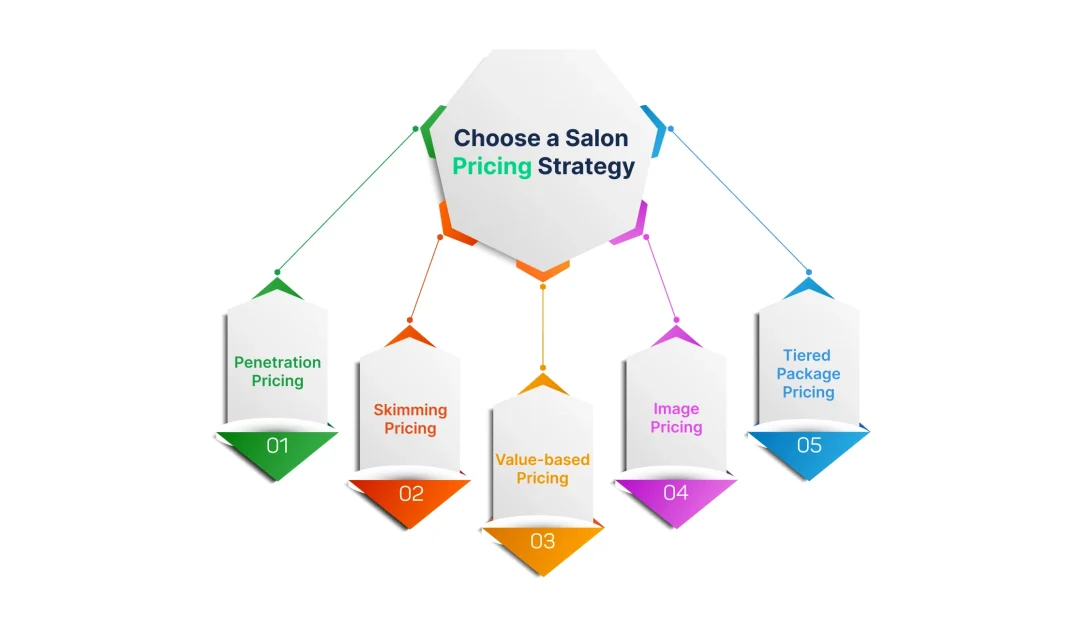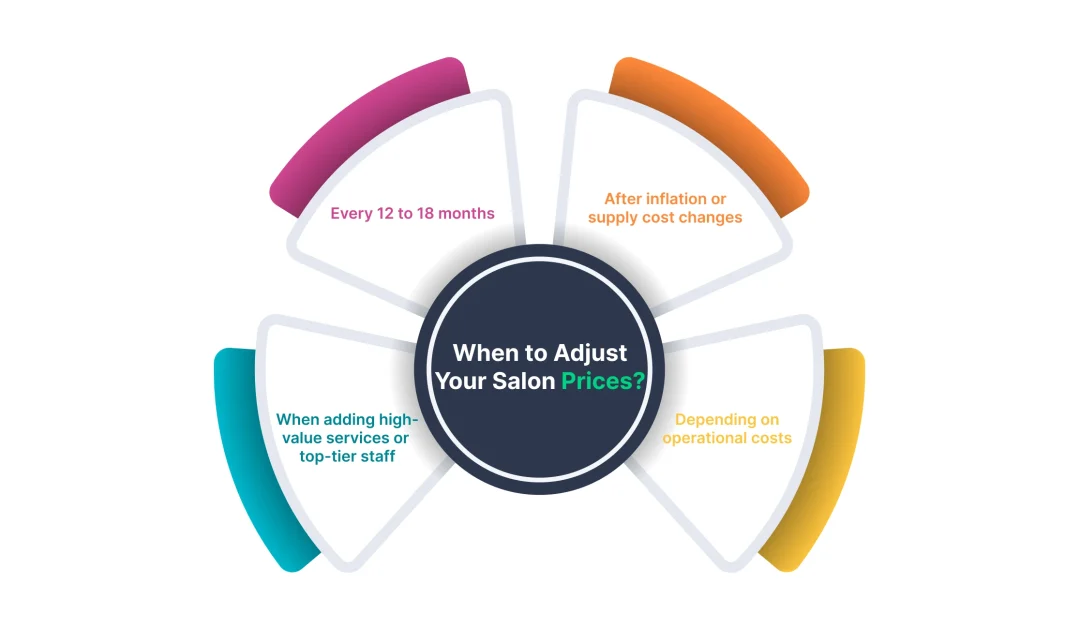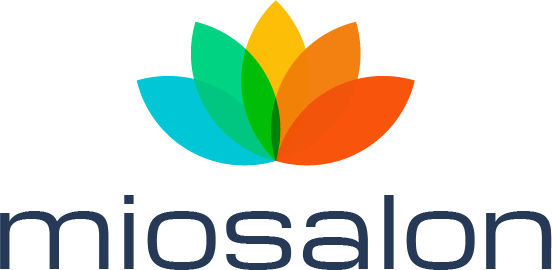Smart Salon Pricing Strategies to Boost Profitability in 2025

Introduction
Every salon owner’s primary goal is to boost sales and drive profitability. Achieving this doesn’t happen overnight, but with the right approach, you can grow your business and become the most sought-after salon in town. One key element to focus on is your salon business plan, particularly your salon pricing strategy.
The way you price your services speaks volumes about your beauty business. Utilising salon management software can help you analyse trends, track expenses, and adjust prices accordingly, making sure your services are priced optimally to reflect your business value.
This blog will give you the tips and tricks to set the price right for your salon. This will also help you to increase your salon’s profitability.
Factors that Influence a Salon’s Pricing Strategy
If you’re wondering how to set salon prices, these are a few factors you must consider:
1. Consider Your Salon’s Location
Set prices based on the,
- Local market
- Neighbourhood profile, and
- Client spending behaviour.
Location is one of the most critical factors to consider when setting prices for your salon services. Start by examining the area where your salon is located.
Is it a high-end neighbourhood, a busy urban centre, or a quieter suburban area? Conducting a thorough location analysis will help you understand the socioeconomic status of your target market, including their average income and purchasing power.
This information is essential for determining the kind of clients you want to attract and how much they are willing to pay. If you manage multiple salon locations, this analysis becomes even more important.
2. Reflect the True Value of Your Services
Highlight the quality, expertise, and results your salon delivers to justify premium pricing. When you’re a newbie in the salon industry, it can be quite tempting to discount your prices.
Well, offering initial discounts might seem like a good idea if you want to get the first bookings. However, remember you still need to pay bills. If you want to maximise profitability, you cannot charge less than you’re spending.
Before you create your salon pricing strategy, understand how much each service costs in terms of time spent, products used, and employee training. The price you offer should cover these three things. Anything that you make after your break-even point (BEP) on each item on your menu is your profit.
3. Demand Trends
Once you’ve zeroed down on who your target market is, their location, and the kind of lifestyle they live, you will have to understand which salon services are the most popular amongst them. When you have a basic idea of the services that have a higher demand, you can adjust your prices accordingly.
Check social media to see what’s trending. You can even research your competitors to get useful insights into what’s popular and what’s not. This will help you price your services accordingly.
4. Competitors’ Pricing Plan
There are no two thoughts about the fact that the salon business is a competitive market. When you’re creating a salon pricing strategy, take a look at your competition and examine their menu too.
However, only take inspiration from them if their salon is on the same page as yours. For example, if you have a salon in the suburban area of a city, you cannot possibly charge like a salon that has its outlet in an upmarket area.
Having hair salon software ensures your clients are charged as per the prices set on your salon menu. It does not just ensure your team does not undercharge but also helps you intimate clients about changing prices.
While watching your competitor’s pricing techniques is important. As a salon owner, you make your pricing decisions based on the costs you are incurring every month.
5. Fixed vs Variable Costs
To calculate the price of every salon service, it is important for a salon owner to understand how much it costs. Every salon business has to take care of two kinds of costs – fixed and variable.
As the name implies, fixed costs include those expenses that are fixed for a month and are mandatory. Some of the expenses that fall into this category include – rent, utilities, employee salary, marketing, maintenance, supplies, taxes, insurance, and other miscellaneous things.
How to Calculate the Right Price for Salon Services?
Pricing isn’t a guess. Use this simple formula:
Cost per Service = (Fixed Costs + Variable Costs + Desired Profit) ÷ Total Monthly Services
Let’s assume:
A mid-range salon with 1 manager, 7 staff, and 1 cleaning staff gets an average of 500 bills/month. The rent for the salon is Rs. 50,000 (negligible if own property), the electricity bill is around Rs. 10,000, and the staff salary is an average of Rs. 30,000.
| Fixed Cost | Cost(Rupees) | Total Cost(Rupees) |
| Rental cost | 50,000 | 50,000 |
| Electricity bill | 10,000 | 10,000 |
| Staff salary | 1 Manager = 30,0007 Staff Member = 23,000 Average1 Cleaning Staff = 10,000 | 2,01,000 |
| Miscellaneous | 5,000 | 5,000 |
| Marketing | 10,000 | 10,000 |
| Maintenance | 10,000 | 10,000 |
| Grand Total cost | – | 2,96,000 |
Now, if we sum up these expenses, let’s assume the running expense for a mid-range Salon is Rs. 2,96,000/Month.
Besides fixed costs, there are even variable costs, which include all the expenses that vary every month. Every service is completely dependent on these variable costs. It usually includes incentives, the number of products used, and employee working hours.
Let’s assume,
| Variable Incentive | 10% |
| Product Usage | 5% |
| Salon’s Profit | 20% |
| Fixed cost (65% Fixed cost = 100% of Revenue) | 65% (2,96,000) |
| Therefore, Revenue 100% | = 4,55,385 |
As mentioned above, if the salon gets 500 bills/month on average (4,55,385 / 500), the average bill value will be Rs. 911
Assume average service/Bill = 1.75 (Haircut, Shaving, Facial, hair spa, hair colouring, etc.)
Total services taken/Month = 500 x 1.75 = 850 services
According to statistics, 90% of salon bills are for haircuts. (No. of bills x 90/100)
| Services taken | No. of services | Cost/service | Total Cost |
| Hair Cut | 450 | 280 | 1,26,000 |
No. of haircuts x total service cost = 1,26,000
Remaining services (total no. of services – Haircuts) = 850 – 450 = 400 other services
Other services (400) are split into
| Services taken | No. of services | Cost/service | Total Cost |
| Beard shaping and Shaving | 200 | 200 | 40,000 |
| Massage Service | 100 | 400 | 40,000 |
| Hair treatment | 50 | 2000 | 1,00,000 |
| Facial | 50 | 3000 | 1,50,000 |
| Grand Total | 400 | – | 3,30,000 |
No. of other services x Service Cost = 3,30,000
Total bill value = (No. of haircuts x total service cost) + (No. of other services x Service Cost)
= 1,26,000 + 3,30,000 = 4,56,000
The total bill value should match the revenue value or exceed the revenue value.
Once you have the math in place, it becomes easier for you to price your salon services. Also, remember to take into consideration other factors as well.
Also Read: 7 Surprising Benefits of Salon Management Software That Will Transform Your Business!
Choose a Salon Pricing Strategy

After you decide how you’re going to charge for the service your salon offers, you can even choose a pricing strategy. You can even modify this strategy from time to time.
With a salon pricing strategy in place, you will even get an idea about when you should offer discounts, how to sell services, gain profit from prepaid, packages, and membership or when you should raise prices to maximise revenue.
Some of the most popular pricing strategies used by hair salons across the world include:–
➢ Penetration Pricing:
If you’re new to the salon business, this strategy will help you. As the name implies, it will help you penetrate the market. In this strategy, the services are priced low so that they appeal to customers whose buying decision mainly depends on price.
With this strategy, you might be able to get clients through the door and have appointments booked. However, in the long run, it isn’t the best pricing model to follow.
This is mainly because once customers get used to paying a certain amount of money for a service, they might discontinue doing business with you in case you hike your prices.
➢ Skimming Pricing:
If your salon is planning to introduce new or exclusive services, you can follow this pricing structure. It involves setting higher prices for these services and moving these costs lower over time. It is a great way to attract customers with high spending power.
Once the novelty of the service wears off, you can decrease the prices. For example, if a particular hair colour is trending, charge a premium for it. When the craze for the trends subsides, get it back to its original price.
➢ Value-based Pricing:
Value-based pricing is a more customer-centric approach to determining your pricing structure. It usually involves a customer’s willingness to pay for a service. To adopt this strategy, you will have to take into account every customer’s preference and whether they’re willing to spend an ‘x’ amount on a service.
For this model to succeed, you need to understand your clients well. Therefore, this model is only recommended for established salons.
➢ Image Pricing:
The last pricing model is called image pricing or prestige pricing. If you think your salon is a prestigious brand or if you have recruited top hairstylists, this model might work for you.
A lot of salons that have established a strong brand image use this kind of pricing. This pricing strategy will also help you attract high-spending clients.
➢ Tiered Package Pricing:
Offer service bundles at different levels (basic, premium, deluxe).
Tiered Stylist Pricing Strategy: Junior, Senior & Creative Director
Many high-performing salons offer pricing based on the experience and reputation of their stylists. This model maximises revenue while offering flexibility to clients.
- Junior Stylist: Ideal for basic services or walk-ins. Lower rates to attract budget-conscious clients.
- Senior Stylist: Higher prices based on advanced training and experience. Great for regular clients who expect reliable quality.
- Top Stylist: Expensive prices based on seniority. This is for high-spending clients expecting a premium look.
- Creative Director: Premium rates for signature services or trendsetting transformations. Often used for consultations, complex cuts, and exclusive styles.
This strategy encourages team growth, builds loyalty, and allows clients to choose based on both budget and expertise.
Salon Services That Can Command Premium Pricing
Some services naturally justify a higher price tag. Examples include:
- Hair Spa & Scalp Therapies
- Bridal or Pre-bridal Packages
- Custom Hair Colour Treatments
- Skin Therapies and Anti-Ageing Facials
- Monthly Memberships and Loyalty Programs
When to Adjust Your Prices?

Salon pricing isn’t set in stone. Re-evaluate your pricing
- Every 12 to 18 months
- After inflation or supply cost changes
- When adding high-value services or top-tier staff
- Depending on operational costs
How MioSalon Helps Salon Owners Keep Records Organised
Pricing Strategy
Managing a salon is more than just offering great services; it’s about making data-driven decisions that fuel growth and profitability. With MioSalon’s Analytics and Reports feature, salon owners can easily stay on top of every important business metric.
Here’s how:
Centralised Record-Keeping Made Easy
MioSalon automatically tracks and organises all your salon data in one place, from client visit histories and staff performance to service-wise revenue and product sales. No more scattered spreadsheets or manual logbooks.
With just a few clicks, you can access:
- Daily, weekly, and monthly sales reports
- Staff productivity and performance metrics
- Client retention and rebooking patterns
- Inventory movement and wastage reports
This level of detail ensures salon owners have a clear view of what’s working and what needs improvement.
Smarter Pricing Strategy
Setting the right price isn’t guesswork; it’s strategy. MioSalon helps you base your pricing decisions on real-time data.
You can:
- Identify high-demand services and adjust pricing to reflect their popularity
- Track profit margins across services and products
- Compare the revenue generated by each staff member or service category
- Analyse peak hours and apply premium pricing during high-traffic slots
By using these insights, salon owners can optimise their pricing structure to boost profitability without losing clients.
Using advanced technology allows you to stay updated with current expenses, client preferences, and market trends. It can help you set competitive prices while ensuring profitability.
FAQs:-
- How do I determine the right price for my salon services?
You can determine the right price by evaluating fixed and variable costs, understanding your target market, analysing competitors, and using salon software like MioSalon for data-driven insights. - What are the most effective salon pricing strategies?
Popular salon pricing strategies include penetration pricing, value-based pricing, skimming pricing, and image pricing. Each caters to different stages of business growth and client demographics. - Should I price my salon services based on competitors?
While it’s good to be aware of competitor prices, your pricing should primarily reflect your cost structure, service quality, and target customer segment. - How does salon software help in managing pricing?
MioSalon helps track revenue, analyse high-performing services, monitor client demand trends, and calculate profitability, making pricing decisions easier and more accurate. - How often should salon prices be updated?
It’s recommended to review your salon pricing strategy at least every 6 months or after major changes in costs, service demand, or market trends.
Conclusion
Salon pricing might seem daunting initially. But once you have understood your running costs, clients, and pricing structure, you will be well on your way to making profits.
If you want to attract more customers to your salon, keep the cost of your haircut and beard services low. When they come into use of these services, you can even upsell other services to further boost profits.
If you’re looking for a one-stop solution to manage salon pricing and update prices periodically, consider getting MioSalon, salon software. It helps customers schedule appointments, check your salon menu, and helps you engage with them better.
Schedule a Free Demo today and see the magic unfold.
How to Get Started?
1. Book a Free Demo – See MioSalon in action. Our team will walk you through the features that match your salon’s needs.
2. Personalised Onboarding – Once you’re ready, we’ll set up your account, import your data, and tailor the software to your services, team, and preferences.
3. Staff Training & Support – We’ll train your team to use the system smoothly, including appointments, payments, client records, and more.
4. Go Live – Start taking bookings, sending reminders, and managing your salon efficiently. You’re all set to shine.
Start your Free Demo and see how MioSalon helps you streamline appointments, staff schedules, and client communication, all while improving salon etiquette and experience.
Want pricing info? Check out our Plans & Pricing page.



